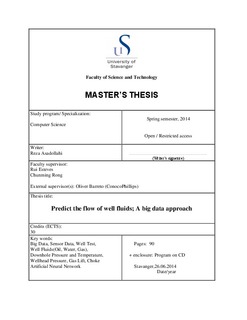| dc.description.abstract | In the oil and gas industry, millions of records of data are registered every day. The data is composed by a mix of structured and unstructured sources. For example downhole gauges and wellhead sensors are logging pressure and temperature in different places of the well. Emerging technologies such as fiber-optic, wireless communication, allow the sensors to be digital, more accurate and reliable. The number of sensors as well as their resolution increase, which imposes new challenges in terms of amount of data that is necessary to be processed. Moreover, engineers in oil and gas industry store well operations, interventions logs and their interpretation in different files and formats. Combining and analyzing these different types of data is a worthy challenge for each company to obtain valuable information.
The production/performance engineers need the production rates to monitor the well situation and optimize the well performance. However, in a production well, the well production rates are not determined in real time. To measure the fluid rates Well Test operation is carried out periodically, normally once a month. However, these rates might change dramatically within two Well Test. For this reason, a model that can predict the fluid rates, gives great advantages to the production engineers to optimize the well performance in real time.
In this thesis a real usecase of an oil well was studied and an approach was proposed to process and analysis a large amount of structured and unstructured data using Exploratory Data Analysis (EDA) and design an Artificial Neural Network (ANN) to predict the flow of the well fluids. The usefulness of this method has been proved by predicting the rates of the well fluids for the usecase with reasonable low errors. Moreover, we proposed a second approach that increased even more the network accuracy[lower errors]. | nb_NO |
